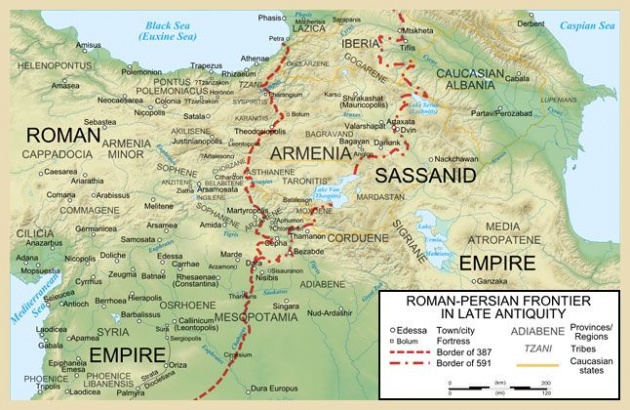Most of the Arabian Peninsula remained outside the direct control of these two world powers. The predominance of vast barren desert, alleviated only by a few water sources where agricultural communities gathered, such as Ta’if and Yathrib, made complete colonization unattractive. Nevertheless, both empires competed to establish alliances with tribes via barter and bribery as they tried to control trade routes. Competitive efforts from both Empires focused particularly on Yemen in the South. There agriculture thrived due to an ancient irrigation system of large water tunnels in the mountains, and dams, the most impressive of which was known as the Ma’rib Dam, built ca. 700 BCE. The ancient states of Saba, Ma’in, Qataban, Hadhramaut, Awsan, and Himyar evolved in this region, thanks to the cultivation and trade of spices and aromatics, including frankincense and myrrh, highly valued by the surrounding cultures. The Mar’rib Dam collapsed in AD 570. This is noted in the Qur’an and the consequent failure of the irrigation system provoked the migration of up to 50,000 people, who were forced to survive the harsh environment, taking refuge with other tribes as they were able.
 The sixth century saw Bedouin tribes on well-saddled camels employed by foreign merchants to transport goods and guide caravans from one well to another by direct route across the steppes. Thus goods from India, East Africa, Yemen and Bahrain traveled on to both Byzantium and Syria.
The sixth century saw Bedouin tribes on well-saddled camels employed by foreign merchants to transport goods and guide caravans from one well to another by direct route across the steppes. Thus goods from India, East Africa, Yemen and Bahrain traveled on to both Byzantium and Syria.
Nomadic (badawah) life was harsh. Scarce resources meant that survival depended upon close-knit family and kinship groups or “tribes.” Too few resources led to endless battles with other tribes for water, pastureland and grazing rights. A tribe’s sheep, goats, horses, camels and slaves were under constant threat from an acquisition raid, or ghazu. The ghazu was a form of negative reciprocity and an accepted part of life necessitated by the fact that there was simply not enough to go around, particularly when water holes dried up and all food sources failed. These kinds of raids had become endemic during the century preceding Mohammad’s revelation, and often escalated from quarrels into decades of warfare between tribes. The Days of al-Fijar in which the Quraysh and the Kinanah opposed the Hawazin is an example of this, and the young Mohammad, who was a member of the Quraysh from the distinguished clan of Hashim, is said to have participated.
To be successful a tribe needed members who would not be defeated by the overwhelming harshness of life in the arid desert. As a consequence each tribe’s life and culture evolved around a chivalric code (muruwah) that was an attempt to overcome life’s severe conditions, give meaning to the Arab’s world and prevent people from giving in to despair. “Muruwah meant courage, patience, endurance; it consisted of a dedicated determination to avenge any wrong done to the group, to protect its weaker members, and defy its enemies. To preserve the honor of the tribe, each member had to be ready to leap to the defense of his kinsmen at a moment’s notice and to obey his chief without question. … Above all, a tribesman had to be generous and share his livestock and food. … A truly noble Bedouin would take no heed for the morrow, showing by his lavish gifts and hospitality that he valued his fellow tribesmen more than his possessions.... ” (Muhammad A Prophet of our Time, Karen Armstrong) Struggle was glorious, arrogance a sign of nobility and humility a sign of weakness.
Within the tribe the Law of Retribution was arbitrated and administered by the chief, or Sheykh: injured parties could claim retribution – an act of aggression would be avenged in equal terms – the killing of a neighbor’s son or camel meant the execution of one’s own son or camel. To facilitate retribution a “blood money” value was set for everything: individuals, goods and assets.
In an age where outside the tribe the individual was totally vulnerable, it was the idea of hospitality (diyafah) that enabled travel through tribal territories. “Arabian tribesmen view hospitality as a sacred duty; the pagan poets of the Jahiliya praised it as a cardinal virtue and archetyped it in the celebrated legend of Hatim al-Ta’I. Elaborate rules governed the granting and termination of hospitality to persons outside the lineage, doubtless in response to the functional significance of the traveller.” In his book “The Places Where Men Pray Together: Cities in Islamic Lands Seventh Through Tenth Centuries,” the scholar Paul Wheatley goes on to say that providing protection and safe conduct to strangers displayed the authority of the Sheykh and his tribe and confirmed their control over the territory.
By the end of the sixth century the weakness of muruwah was apparent: each tribe had its own inherited rules, many of which led to reckless and extreme behavior. By this time, too, Yemen had become a province of Persia. With no hope of anything better the Bedouin saw themselves in a life of struggle, relieved only by moments of pleasure, often taken in the oblivion of date wine, and constantly open to exploitation by the two Empires. There was thought to be nothing wrong with stealing, injuring or murdering people outside one’s own tribe, so peace depended on a fragile stability created through alliances and affiliations between tribes. This depended more on the threat of retaliation and the comparative strength of each than on anything else. One can imagine that many tribes’ members, especially the weak, the old, women and children, lived in constant terror. Chaos was spreading all over the Arab Peninsula. Incessantghazu raids now led to what seemed to be a constant state of warfare between tribes, a condition that was exacerbated by unprecedented drought and famine.
A state of mind prevailed that the Prophet Mohammad called jahiliyyah, which, according to Karen Armstrong, translates as: “violent and explosive irascibility, arrogance, tribal chauvinism.” This same word would later be understood to mean the pre-Islamic historical period itself, translated as “The Time of Ignorance.”
The Quraysh had been in control of Mecca (Makkah) since the fourth century. In the middle of the Hijaz, a region in the west of present-day Saudi Arabia, it had become a major commercial center at the crossroads of trade caravans linking Arabia with India, Persia, China, and Byzantium, and had its own Red Sea port at Shu‘ayba. Unlike other tribal settlements developed around water sources, Mecca’s stony infertile ground made agriculture impossible, so survival centered around commerce. During the last years of the sixth century the Quraysh had become extremely successful at this, but by the mid-seventh century ruthless capitalism had eroded their traditional egalitarian way of life. Quraysh society was now stratified, with its wealth confined to a few ruling families; the weaker, poorer, marginalized clans and individuals were left, lost and disoriented on the outside.



